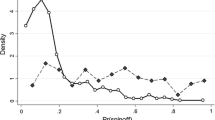Abstract
Using the university–industry co-publications (UICP) propensity indicators developed by Tijssen (CWTS Working Paper Series, CWTS-WP-2012-009, 2009), this paper examines the impact of university–industry R&D collaboration on university technology commercialization output for leading US and Canadian universities. Our analysis suggests that UICPs do have a significant positive influence on universities’ technology commercialization outputs, after controlling for the quantity and quality of their research and for their commercialization resources. The results are robust for all three common measures of university technology commercialization: patenting (both in terms of simple patent counts and citation-weighted counts), spin-off formation, and technology licensing. To supplement the aggregate regression findings, five case studies are provided that offer further insights on the causal mechanisms involved. Implications of these findings and possible future research directions are discussed.
Similar content being viewed by others
Notes
In this and later studies (e.g. Tijssen et al. 2009), Tijssen uses the term ‘intensity’ in reference to the share of co-authored publications relative to total publications. We have replaced this term with ‘propensity’ as it more accurately reflects the meaning of the ratio.
Due to data availability restrictions, the citation-weighted patents were calculated based on patents issued between 2006 and 2008, with citations up to 2009.
The 2005 SCI sub-index also includes publications listed in the Arts & Humanities Citations Index (AHCI). However, we do not believe this change of definition materially changes our results. The correlation between the sub-index for 2005 is highly correlated with the data for 2006 (r = 0.998, p = 0.000), 2004 (r = 0.995, p = 0.000) and 2003 (r = 0.993, p = 0.000)].
See Appendix 2 for more details.
References
Ambos, T. C., Mäkelä, K., Birkinshaw, J., & D’Este, P. (2008). When does university research get commercialized? Creating ambidexterity in research institutions. Journal of Management Studies, 45(8), 1424–1447.
Baldini, N. (2006). University patenting and licensing activity: A review of the literature. Research Evaluation, 15(3), 197–207.
Calvert, J., & Patel, P. (2003). University–industry research collaborations in the UK: Bibliometric trends. Science and Public Policy, 30(2), 85–96.
Carayol, N., & Matt, M. (2004a). The exploitation of complementarities in scientific production process at the laboratory level. Technovation, 24, 455–465.
Carayol, N., & Matt, M. (2004b). Does research organization influence academic production? Laboratory evidence from a large European university. Research Policy, 33(2004), 1081–1102.
Catley, L., Weisberg, E., Tai, Y. T., Atadja, P., Remiszewski, S., Hideshima, T., et al. (2003). NVP-LAQ824 is a potent novel histone deacetylase inhibitor with significant activity against multiple myeloma. Blood, 102(7), 2615–2622.
Catley, L., Weisberg, E., Kiziltepe, T., Tai, Y. T., Hideshima, T., Neri, P., et al. (2006). Aggresome induction by proteasome inhibitor bortezomib and alpha-tubulin hyperacetylation by tubulin deacetylase (TDAC) inhibitor LBH589 are synergistic in myeloma cells. Blood, 108(10), 3441–3449.
D’Este, P., & Patel, P. (2007). University–industry linkages in the UK: What are the factors underlying the variety of interactions with industry? Research Policy, 36, 1295–1313.
Di Gregorio, D., & Shane, S. (2003). Why do some universities generate more start-ups than others? Research Policy, 32, 209–227.
Etzkowitz, H. (2003). Innovation in innovation: the triple helix of university–industry–government relations. Social Science Information, 42(3), 293–337.
Etzkowitz, H., & Leydesdorff, L. (2000). The dynamics of innovation: from national systems and “Mode 2” to a triple helix of university–industry–government relations. Research Policy, 29(2), 109–123.
Etzkowitz, H., Webster, A., Gebhardt, C., & Terra, B. R. C. (2000). The future of the university and the university of the future: Evolution of ivory tower to entrepreneurial paradigm. Research Policy, 29(2), 313–330.
Glänzel, W., & Schlemmer, B. (2007). National research profiles in a changing Europe (1983–2003: An exploratory study of sectoral characteristics in the triple helix. Scientometrics, 70(2), 267–275.
Grandi, A., & Grimaldi, R. (2003). Exploring the networking characteristics of new venture founding teams. Small Business Economics, 21(4), 329–341.
Isabelle, M. (2007). Explaining the balance between publications and patents as outputs from public-private collaborative R&D. Paper presented at the DRUID Summer Conference 2007 on Appropriability, Proximity, Routines and Innovation, Copenhagen, Denmark, June 18–20.
Lee, D. H., Seo, I. W., Choe, H. C., & Kim, H. D. (2012). Collaboration network patterns and research performance: The case of Korean public research institutions. Scientometrics, 91, 925–942.
Levy, R., Roux, P., & Wolff, S. (2009). An analysis of science–industry collaborative patterns in a large European University. Journal of Technology Transfer, 34, 1–23.
Lundberg, J., Tomson, G., Lundkvist, I., Skår, J., & Brommerls, M. (2006). Collaboration uncovered: Exploring the adequacy of measuring university–industry collaboration through co-authorship and funding. Scientometrics, 69(3), 575–589.
Meister, S., Peng, H., McIlwrath, K., Jarausch, K., Zhang, X. F., & Cui, Y. (2006). Synthesis and characterization of phase-change nanowires. Nano Letters, 6(7), 1514–1517.
Mowery, D. C. (2007). University–industry research collaboration and technology transfer in the United States since 1980. In S. Yusuf & K. Nabeshima (Eds.), How universities promote economic growth (pp. 163–182). Washington, DC: World Bank.
Mowery, D. C., & Ziedonis, A. A. (2002). Academic patent quality and quantity before and after the Bayh–Dole act in the United States. Research Policy, 31, 399–418.
O’Shea, R. P., Allen, T. J., Chevalier, A., & Roche, F. (2005). Entrepreneurial orientation, technology transfer and spinoff performance of U.S. universities. Research Policy, 34, 994–1009.
Office of Technology Licensing, Stanford University (2006). Contributing to the whole: Stanford University Office of Technology Licensing Annual Report 2005–2006, http://otl.stanford.edu/documents/otlar06.pdf.
Owen-Smith, J., & Powell, W. W. (2003). The expanding role of university patenting in the life sciences: Assessing the importance of experience and connectivity. Research Policy, 32(9), 1695–1711.
Perkmann, M., & Walsh, K. (2007). University–industry relationship and open innovation: Towards a research agenda. International Journal of Management Reviews, 9(4), 259–280.
Ponds, R., van Oort, F., & Frenken, K. (2007). The geographical and institutional proximity of research collaboration. Papers in Regional Science, 86(3), 424–443.
Powers, J. B. (2003). Commercializing academic research: Resource effects of performance of university technology transfer. Journal of Higher Education, 74(1), 291–311.
Powers, J. B. (2004). R&D funding sources and university technology transfer: What is stimulating universities to be more entrepreneurial? Research in Higher Education, 45(1), 1–23.
Powers, J. B., & McDougall, P. P. (2005). University start-up formation and technology licensing with firms that go public: A resource-based view of academic entrepreneurship. Journal of Business Venturing, 20, 291–311.
Rigby, J., & Edler, J. (2005). Peering inside research networks: Some observations on the effect of the intensity of collaboration on the variability of research quality. Research Policy, 34(6), 784–794.
Sætre, A. S., Wiggins, J., & Atkinson, O. T. (2009). University spin-offs as technology transfer: A comparative study among Norway, the United States and Sweden. Comparative Technology Transfer and Society, 7(2), 115–145.
Sampath, H., & Paulraj, A. (2002). Linear precoding for space-time coded systems with known fading correlations. IEEE Communications Letters, 6(6), 239–241.
Santoro, M. D. (2000). Success breeds success: The linkage between relationship intensity and tangible outcomes in industry–university collaborative ventures. The Journal of High Technology Management Research, 11(2), 255–273.
Santoro, M. D., & Chakrabarti, A. K. (2002). Firm size and technology centrality in industry–university interactions. Research Policy, 31(7), 1163–1180.
Sine, W. D., Shane, S., & Di Gregorio, D. (2003). The halo effect and technology licensing: The influence of institutional prestige on the licensing of university inventions. Management Science, 49(4), 478–496.
Tijssen, R. J. W. (2006). Universities and industrially relevant science: Towards measurement models and indicators of entrepreneurial orientation. Research Policy, 35, 1569–1585.
Tijssen, R. J. W. (2009). R&D globalization processes and university–industry research cooperation: Measurement and indicators. CWTS Working Paper Series, CWTS-WP-2012-009, Centre for Science and Technology Studies (CWTS), Leiden University.
Tijssen, R. (2012). R&D globalization processes and university–industry research cooperation: Measurement and indicators. CWTS Working Paper Series, CWTS-WP-2012-009, Centre for Science and Technology Studies (CWTS), Leiden University.
Tijssen, R. J. W., van Leeuwen, T. N., & van Wijk, E. (2009). Benchmarking university–industry research cooperation worldwide: performance measurements and indicators based on co-authorship data for the world’s largest universities. Research Evaluation, 18(1), 13–24.
Trajtenberg, M. (1990). A penny for your quotes: Patent citations and the value of innovations. Research Policy, 21(1), 172–187.
Vinig, G. T., & Van Rijsbergen, P. (2009). Determinants of university technology transfer—Comparative study of US, Europe and Australian universities. http://ssrn.com/abstract=1324601.
Wayne, K.T., & College, R. (2010). Determinants of commercial innovation for university technology transfer. Journal of Behavioral Studies in Business, 2. http://www.aabri.com/manuscripts/09319.pdf.
Weisberg, E., Catley, L., Kujawa, J., Atadja, P., Remiszewski, S., Fuerst, P., et al. (2004). Histone deacetylase inhibitor NVP-LAQ824 has significant activity against myeloid leukemia cells in vitro and in vivo. Leukemia, 18(12), 1951–1963.
Wender, P. A., Rothbard, J. B., Jessop, T. C., Kreider, E. L., & Wylie, B. L. (2002). Oligocarbamate molecular transporters: Design, synthesis, and biological evaluation of a new class of transporters for drug delivery. Journal of the American Chemical Society, 124(45), 13382–13383.
Wong, P.K., Ho, Y.P., & Singh, A. (2009). Towards a “Global Knowledge Enterprise”: The Entrepreneurial University Model of the National University of Singapore”. In: The role and impact of universities in a national innovation system. Vol 1 of A SPF Project Report on Initiatives in Comprehensive Understanding of Civilizational Issues: A New Era of Science and Bioethics. Singapore: NUS Entrepreneurship Centre.
Wong, P. K., & Singh, A. (2009). University patenting activities and their link to the quantity and quality of scientific publications. Scientometrics, 83(1), 271–294.
Author information
Authors and Affiliations
Corresponding author
Appendices
Appendix: 1 Construction of a citation-weighted patent count
Following Trajtenberg (1990), a linear weight was used, with the citation-weighted patent count (WPC) in year t being.
\( {\text{WPC}}_{\text{t}} = \sum\limits_{i = 1}^{{n_{\text{t}} }} {(1 + C_{\text{i}} )} \), where n t = number of patents issued to the university in year t for the years 2006 to 2008, and C i is the number of citations received by each patent i up to the year 2009.
This is a somewhat crude approximation of the true citation-weighted patents count, for two reasons. Firstly, truncation bias means that citations to more recently issued patents are under-represented. Secondly, citations received by patents typically peak 4–5 years after the patent is issued (Mowery and Ziedonis 2002). Since our patents are those issued between 2006 and 2008, and data availability restricts our citation data to 2009, we have captured only a small fraction of the citations that will eventually be made to the patents in our database.
Appendix 2: Results of white test for heteroscedasticity
As can be seen in Appendix Table 7, the results for the White test reveal the presence of heteroscedasticity when using the level values of the dependent variables (DVs) in the regressions for simple patent counts (LM = 48.7, p = 0.00), citation-weighted patent counts (LM = 35.7, p = 0.02) and spin-offs (LM = 50.0, p = 0.00). After applying a square root transformation to the DVs, there is no evidence for heteroscedasticity for the regression for simple patent counts (LM = 30.3, p = 0.06) and citation-weighted patent counts (LM = 17.0, p = 0.65). Although the heteroscedasticity in the regression for spin-offs persists (LM = 42.07, p = 0.03), we did not attempt to further correct this, as the results remain unbiased. For consistency the square root transformation was also applied to the DV for the regression for licenses.
Rights and permissions
About this article
Cite this article
Wong, P.K., Singh, A. Do co-publications with industry lead to higher levels of university technology commercialization activity?. Scientometrics 97, 245–265 (2013). https://doi.org/10.1007/s11192-013-1029-1
Received:
Published:
Issue Date:
DOI: https://doi.org/10.1007/s11192-013-1029-1
Keywords
- University patenting
- Spin-offs
- Licensing
- Publication quantity and quality
- University–industry collaborative research
- Co-publications




